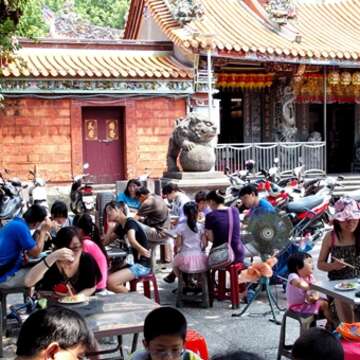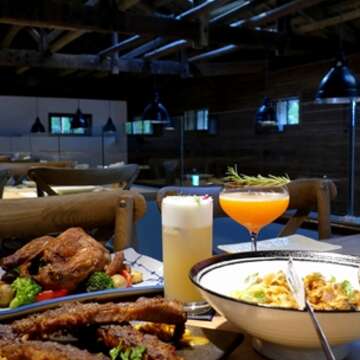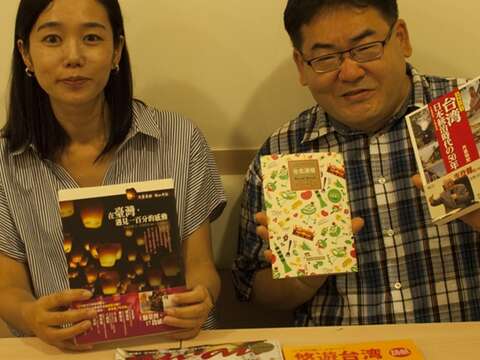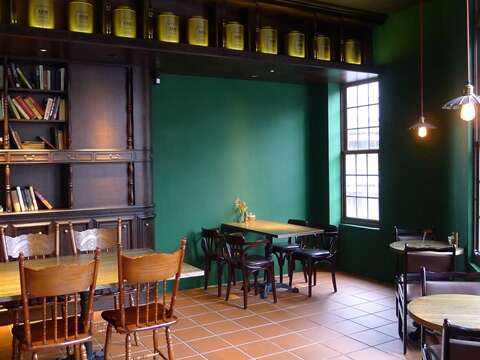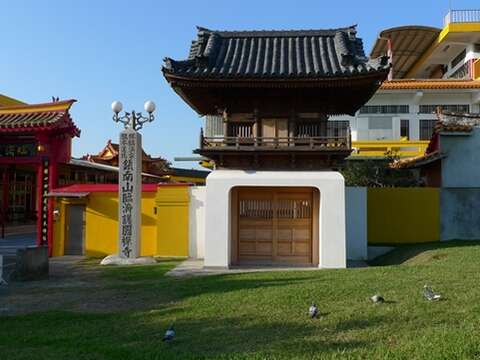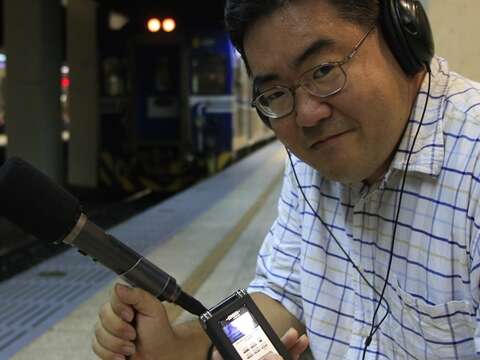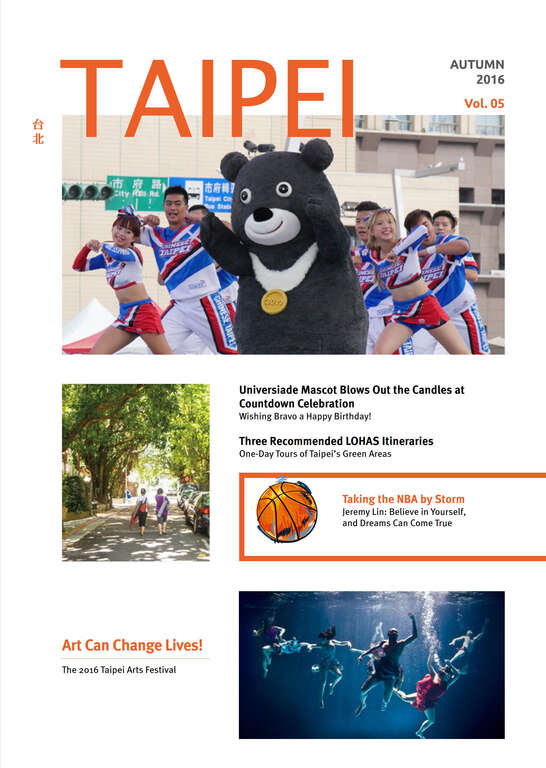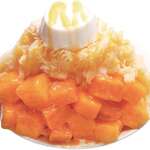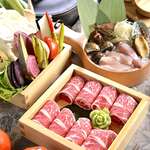Post date:2016-09-29
1244
A Traveler’s Views –
Microscopic and Macroscopic
Article _ Jiang Xinying
Photos _ Yoshifumi Katakura, Chiang Hsinying
Travel involves stepping into unknown, yet beautiful, lands and facing unfamiliar roads, foods, smells, and languages, while wandering about and piecing together a journal of your adventures. Perhaps these are the reasons that travel captivates so many people. Husband-and-wife authors Yoshifumi and Mari Katakura have traveled to more than 60 countries around the world, but have a special liking for Taiwan. In 1997, and again in 1999, they took up residence in and traveled throughout Taiwan, writing, photographing, riding its railways, and researching its history, recording its quintessential cultural practices and customs. Through the eyes of these travelers we see an even more beautiful Taiwan.
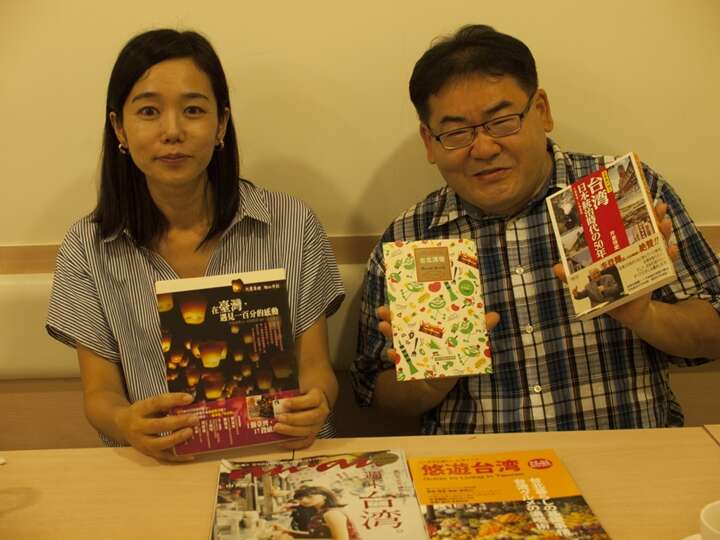
▲ Mari Katakura (left) and Yoshifumi Katakura (right), who have published their own books, present the School Trip Handbook, commissioned by the Department of Information and Tourism, Taipei City Government, which opens from both right and left and features lively and interesting content. (Photo: Chiang Hsinying)
An Island of Stories –
Viewing History Through Travel
For 50 years, from the signing of the Treaty of Shimonoseki in 1895 to 1945, Taiwan experienced various types of interactions between people of different ethnic groups, forging a profound and complicated relationship between Taiwan and Japan. This relationship is today still reflected in such aspects as culture, language, and architecture. Yoshifumi Katakura visited Taiwan for the first time in 1991. Unable to speak Chinese, he used kanji, a system of writing in the Japanese language similar to Chinese characters, to communicate with locals through reading and writing. He was amazed when he came across elderly people who spoke fluent Japanese. Everywhere he went in Taiwan he observed richness in customs and traditions, which attracted him to research the relationships between Taiwan and Japan. He carried out indepth explorations of the remaining traces of Japanese-era history in all areas of Taiwan. In recent years he has made great efforts to locate and interview Japanese, from all over Japan, who were born and received at least part of their education in Taiwan during the Japanese era. This has created a precious repository of images and text related to this era’s people and history.
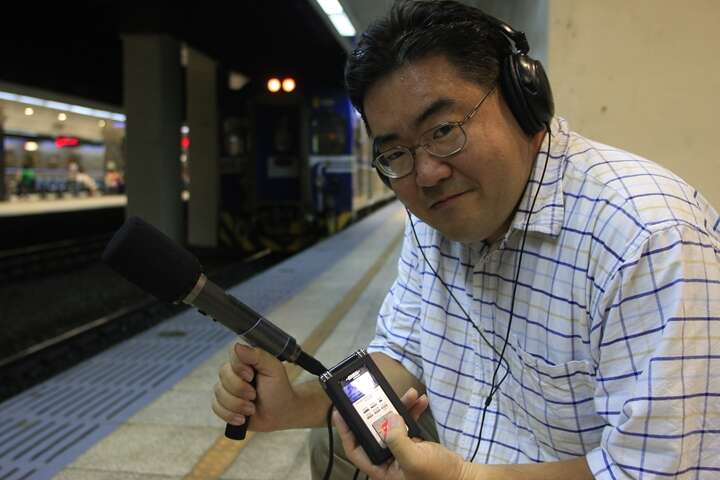
▲ Yoshifumi Katakura records the sounds of Taiwan’s railways, including inside the stations, on the platforms, and in the cars. These detailed recordings, which enable him to catch small details that go unnoticed during everyday activities, is what keeps him motivated. (Photo: Yoshifumi Katakura)
He believes that there are many ways to interpret each event in history, making it difficult to reach a conclusion. He adds that only through in-depth understanding, and by squarely facing all that has happened, can we understand how to respect one another, and that history should not be confined to textbooks. Katakura therefore feels that he has a mission to help younger generations better understand the history and the influences that events of a past era have had on both nations.
According to a study conducted by the Educational Tour Institute, in 2014 Taiwan was the favorite destination among Japanese for overseas field trips, with approximately 28,314 arrivals to Taiwan for this purpose. In 2015 the School Trip Handbook (台北滿喫) was published by the Department of Information and Tourism, Taipei City Government, for which Katakura was specially invited to serve as editor-in-chief. For the planning and images, he collaborated with the cutting-edge Japanese graphic designer Takora Kimiyoshi Futori. The result is an innovative design accompanied by lively content that appeals to young readers. This handbook has become very popular among Japanese youth. Katakura’s schedule now includes about 30 lectures per year in Taiwan and Japan. His topics include food, customs, historical sites, and religious beliefs, i.e. observations of Taiwan from different aspects. His detailed, creative material has inspired more and more people to want to learn about and visit Taiwan.
A City of Stories –
Seeing Life Through Travel
Though they have lived in Taipei for nearly 20 years, Katakura and his wife are still often asked why they like Taiwan. Katakura offers his characteristic squint as he replies: “It seems that the people of Taiwan do not really understand how beautiful Taiwan is.” As a railway enthusiast, he likes to spend his time on and around Taiwan’s railways, especially platforms and cars. He looks for the minutest sounds and images, and enjoys the human touch associated with riding the rails. Specially mentioning the announcements on the metro systems and trains, he says that, “Taiwan is the only place in the world where announcements in cars are made in four or five languages; that’s really unique.” This is something familiar for locals, but a thing of fascination for travelers.
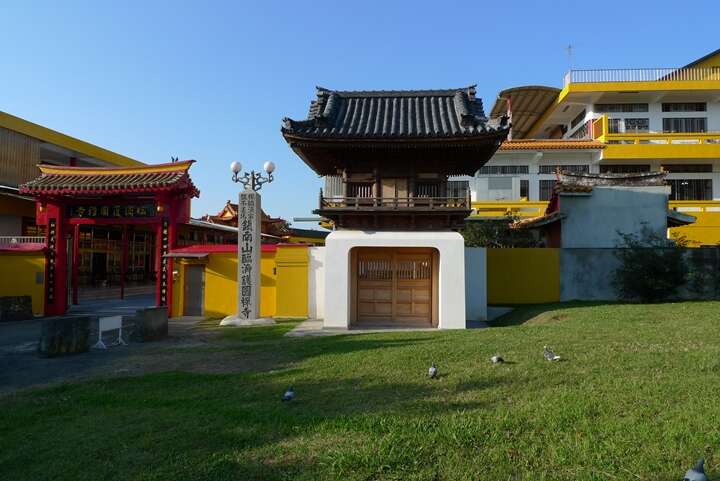
▲ Construction on Linji Huguo Zen Temple, next to MRT Yuanshan Station, began in 1900 and ended in 1911. The architecture of the bell tower gate shown here, adjacent to the main hall, echoes that of the Edo period. (Photo: Yoshifumi Katakura)
Traditional and modern, old-style simplicity and convenience – this mix of historical sites and contemporary architecture is how those traveling through Taipei over the years have described this city. The original Japanese-era appearances of the National Museum of History ( 國立歷史博物館), Museum of Drinking Water ( 自來水博物館), Taipei Guest House (台北賓館), and Presidential Office Building (總統府) have all been retained. Glimpses of history seem to be caught in the exchanges of light and shadow. Both Yangmingshan and Beitou are places to enjoy natural hot springs and relax. Beitou’s green-sulfur hot springs of Long Nice Hot Spring (瀧乃溫泉) are a rarity, found only in Beitou and Tamagawa, Japan. They contain precious trace elements of radium. Said to rid bathers of fatigue, in Japan they are also called healing hot springs. Another of Katakura’s personal favorites is Linji Huguo Zen Temple (臨濟護國禪寺), located next to MRT Yuanshan Station. Founded by a Japanese monk during Taiwan’s Japanese era, it is devoted to worship of the Shakyamuni Buddha. This temple, built in the classic Buddhist temple style of Japan’s Edo period, offers a tranquil environment and beautiful surrounding landscapes, making it well suited to spending a leisurely afternoon.
Katakura enthuses that, “The trees in Taipei’s parks grow very well in summer, and there are so many birds!” During their long time living in Taipei, the Katakuras have been able to observe the vitality of the land from the smallest of details. Even if there has been pruning, when they awake the next morning they can see that the trees and flowers are once again flourishing. They see this as comparable to the vitality of Taiwan, citing how over the past five years they have seen fervent effort all over this island. From The Red House Market for Artists & Designers (西門紅樓創意市 集) to the stylish shops that serve as starting points for the promotion of local agricultural products, such efforts symbolize the hard work and growth of Taiwan’s young people. Katakura says that, “Twenty years have passed, but the things I don’t know seem to grow and grow, making me want to continuously go out and discover.” The Taiwan diaries of the Katakuras continue to be written, and the cultural and ethnic diversity of Taiwan continue to make Taiwan unique in the eyes of world travelers.
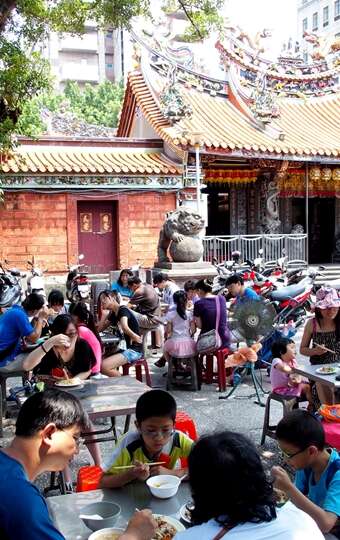
▲
Plaza Before Cisheng Temple (慈聖宮) in Dadaocheng ( 大稻埕)
Under a banyan tree in front of this temple, it is possible to sample a variety of authentic and traditional Taiwanese foods, such as oyster omelets, savory meat congee ( 鹹肉粥), braised pork on rice, and pork sparerib soup ( 排骨湯).
17, Ln. 49, Baoan St.(保安街49 巷17 號)
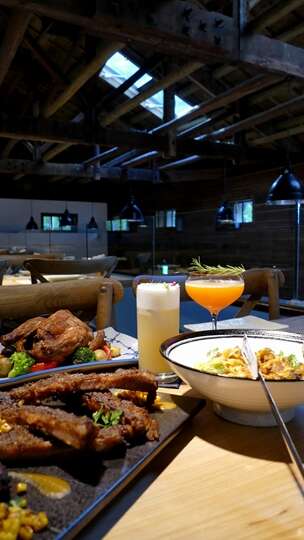
▲
Leputing Brasserie/No. 1Food Theater (樂埔匯農/樂埔町一號糧倉)
Housed in a renovated Japanese-era granary, agricultural products are sold on the first floor. On the second floor is a restaurant. The original structure has been preserved, including the vaulted ceilings. Insistence on the use of local ingredients embodies the “granary” quintessence. This is a fusion-style cultural- creative space that incorporates both history and innovation.
2, Aly. 3, Ln. 346, Sec. 2, Bade Rd. ( 八德路2 段346 巷3 弄2 號)
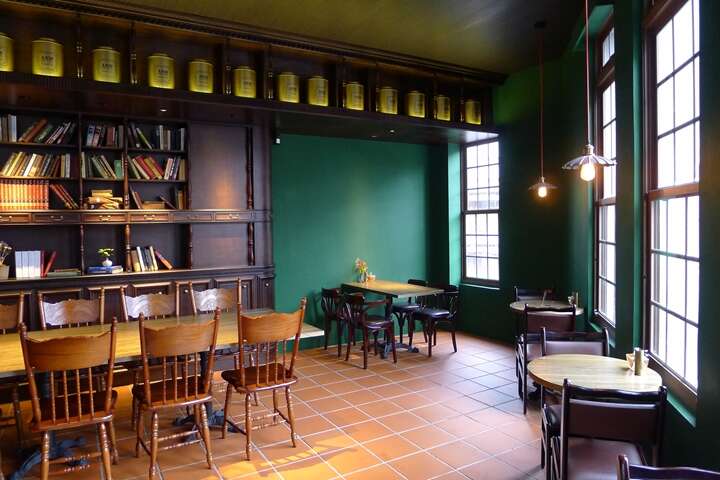
▲
ASW TEA HOUSE
This teahouse, in a Western-style building, is both retro and elegant in style. It sells organic black teas produced in Taiwan. The unique interior design and specially selected teas satisfy the senses of sight and smell. From the second floor, look out over Dadaocheng.
34, Sec. 1, Dihua St.( 迪化街1 段34 號)
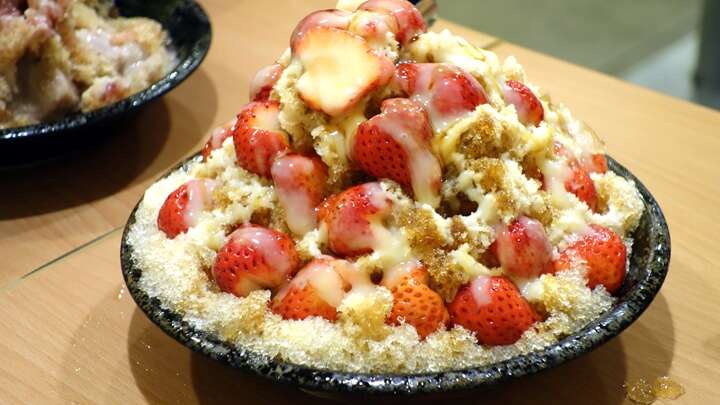
▲
Hei Yan Old-Style Shaved Ice with Brown Sugar (黑岩古早味黑砂糖剉冰)
Here, brown sugar is poured onto finely shaved ice, as in times past. Various ingredients, prepared fresh daily, are then added. Sampling this dish on a hot day is one of life’s great pleasures.
195, Jinzhou St. ( 錦州街195 號)
Microscopic and Macroscopic
Article _ Jiang Xinying
Photos _ Yoshifumi Katakura, Chiang Hsinying
Travel involves stepping into unknown, yet beautiful, lands and facing unfamiliar roads, foods, smells, and languages, while wandering about and piecing together a journal of your adventures. Perhaps these are the reasons that travel captivates so many people. Husband-and-wife authors Yoshifumi and Mari Katakura have traveled to more than 60 countries around the world, but have a special liking for Taiwan. In 1997, and again in 1999, they took up residence in and traveled throughout Taiwan, writing, photographing, riding its railways, and researching its history, recording its quintessential cultural practices and customs. Through the eyes of these travelers we see an even more beautiful Taiwan.

▲ Mari Katakura (left) and Yoshifumi Katakura (right), who have published their own books, present the School Trip Handbook, commissioned by the Department of Information and Tourism, Taipei City Government, which opens from both right and left and features lively and interesting content. (Photo: Chiang Hsinying)
An Island of Stories –
Viewing History Through Travel
For 50 years, from the signing of the Treaty of Shimonoseki in 1895 to 1945, Taiwan experienced various types of interactions between people of different ethnic groups, forging a profound and complicated relationship between Taiwan and Japan. This relationship is today still reflected in such aspects as culture, language, and architecture. Yoshifumi Katakura visited Taiwan for the first time in 1991. Unable to speak Chinese, he used kanji, a system of writing in the Japanese language similar to Chinese characters, to communicate with locals through reading and writing. He was amazed when he came across elderly people who spoke fluent Japanese. Everywhere he went in Taiwan he observed richness in customs and traditions, which attracted him to research the relationships between Taiwan and Japan. He carried out indepth explorations of the remaining traces of Japanese-era history in all areas of Taiwan. In recent years he has made great efforts to locate and interview Japanese, from all over Japan, who were born and received at least part of their education in Taiwan during the Japanese era. This has created a precious repository of images and text related to this era’s people and history.

▲ Yoshifumi Katakura records the sounds of Taiwan’s railways, including inside the stations, on the platforms, and in the cars. These detailed recordings, which enable him to catch small details that go unnoticed during everyday activities, is what keeps him motivated. (Photo: Yoshifumi Katakura)
He believes that there are many ways to interpret each event in history, making it difficult to reach a conclusion. He adds that only through in-depth understanding, and by squarely facing all that has happened, can we understand how to respect one another, and that history should not be confined to textbooks. Katakura therefore feels that he has a mission to help younger generations better understand the history and the influences that events of a past era have had on both nations.
According to a study conducted by the Educational Tour Institute, in 2014 Taiwan was the favorite destination among Japanese for overseas field trips, with approximately 28,314 arrivals to Taiwan for this purpose. In 2015 the School Trip Handbook (台北滿喫) was published by the Department of Information and Tourism, Taipei City Government, for which Katakura was specially invited to serve as editor-in-chief. For the planning and images, he collaborated with the cutting-edge Japanese graphic designer Takora Kimiyoshi Futori. The result is an innovative design accompanied by lively content that appeals to young readers. This handbook has become very popular among Japanese youth. Katakura’s schedule now includes about 30 lectures per year in Taiwan and Japan. His topics include food, customs, historical sites, and religious beliefs, i.e. observations of Taiwan from different aspects. His detailed, creative material has inspired more and more people to want to learn about and visit Taiwan.
A City of Stories –
Seeing Life Through Travel
Though they have lived in Taipei for nearly 20 years, Katakura and his wife are still often asked why they like Taiwan. Katakura offers his characteristic squint as he replies: “It seems that the people of Taiwan do not really understand how beautiful Taiwan is.” As a railway enthusiast, he likes to spend his time on and around Taiwan’s railways, especially platforms and cars. He looks for the minutest sounds and images, and enjoys the human touch associated with riding the rails. Specially mentioning the announcements on the metro systems and trains, he says that, “Taiwan is the only place in the world where announcements in cars are made in four or five languages; that’s really unique.” This is something familiar for locals, but a thing of fascination for travelers.

▲ Construction on Linji Huguo Zen Temple, next to MRT Yuanshan Station, began in 1900 and ended in 1911. The architecture of the bell tower gate shown here, adjacent to the main hall, echoes that of the Edo period. (Photo: Yoshifumi Katakura)
Traditional and modern, old-style simplicity and convenience – this mix of historical sites and contemporary architecture is how those traveling through Taipei over the years have described this city. The original Japanese-era appearances of the National Museum of History ( 國立歷史博物館), Museum of Drinking Water ( 自來水博物館), Taipei Guest House (台北賓館), and Presidential Office Building (總統府) have all been retained. Glimpses of history seem to be caught in the exchanges of light and shadow. Both Yangmingshan and Beitou are places to enjoy natural hot springs and relax. Beitou’s green-sulfur hot springs of Long Nice Hot Spring (瀧乃溫泉) are a rarity, found only in Beitou and Tamagawa, Japan. They contain precious trace elements of radium. Said to rid bathers of fatigue, in Japan they are also called healing hot springs. Another of Katakura’s personal favorites is Linji Huguo Zen Temple (臨濟護國禪寺), located next to MRT Yuanshan Station. Founded by a Japanese monk during Taiwan’s Japanese era, it is devoted to worship of the Shakyamuni Buddha. This temple, built in the classic Buddhist temple style of Japan’s Edo period, offers a tranquil environment and beautiful surrounding landscapes, making it well suited to spending a leisurely afternoon.
Katakura enthuses that, “The trees in Taipei’s parks grow very well in summer, and there are so many birds!” During their long time living in Taipei, the Katakuras have been able to observe the vitality of the land from the smallest of details. Even if there has been pruning, when they awake the next morning they can see that the trees and flowers are once again flourishing. They see this as comparable to the vitality of Taiwan, citing how over the past five years they have seen fervent effort all over this island. From The Red House Market for Artists & Designers (西門紅樓創意市 集) to the stylish shops that serve as starting points for the promotion of local agricultural products, such efforts symbolize the hard work and growth of Taiwan’s young people. Katakura says that, “Twenty years have passed, but the things I don’t know seem to grow and grow, making me want to continuously go out and discover.” The Taiwan diaries of the Katakuras continue to be written, and the cultural and ethnic diversity of Taiwan continue to make Taiwan unique in the eyes of world travelers.

▲
Plaza Before Cisheng Temple (慈聖宮) in Dadaocheng ( 大稻埕)
Under a banyan tree in front of this temple, it is possible to sample a variety of authentic and traditional Taiwanese foods, such as oyster omelets, savory meat congee ( 鹹肉粥), braised pork on rice, and pork sparerib soup ( 排骨湯).
17, Ln. 49, Baoan St.(保安街49 巷17 號)

▲
Leputing Brasserie/No. 1Food Theater (樂埔匯農/樂埔町一號糧倉)
Housed in a renovated Japanese-era granary, agricultural products are sold on the first floor. On the second floor is a restaurant. The original structure has been preserved, including the vaulted ceilings. Insistence on the use of local ingredients embodies the “granary” quintessence. This is a fusion-style cultural- creative space that incorporates both history and innovation.
2, Aly. 3, Ln. 346, Sec. 2, Bade Rd. ( 八德路2 段346 巷3 弄2 號)

▲
ASW TEA HOUSE
This teahouse, in a Western-style building, is both retro and elegant in style. It sells organic black teas produced in Taiwan. The unique interior design and specially selected teas satisfy the senses of sight and smell. From the second floor, look out over Dadaocheng.
34, Sec. 1, Dihua St.( 迪化街1 段34 號)

▲
Hei Yan Old-Style Shaved Ice with Brown Sugar (黑岩古早味黑砂糖剉冰)
Here, brown sugar is poured onto finely shaved ice, as in times past. Various ingredients, prepared fresh daily, are then added. Sampling this dish on a hot day is one of life’s great pleasures.
195, Jinzhou St. ( 錦州街195 號)
Gallery
:::
Popular articles
 TAIPEI QUARTERLY 2016 AUTUMN Vol.05
TAIPEI QUARTERLY 2016 AUTUMN Vol.05 Wishing Bravo a Happy Birthday! (TAIPEI QUARTERLY 2016 AUTUMN Vol.05)
Wishing Bravo a Happy Birthday! (TAIPEI QUARTERLY 2016 AUTUMN Vol.05) Jeremy Lin: Believe in Yourself, and Dreams Can Come True (TAIPEI QUARTERLY 2016 AUTUMN Vol.05)
Jeremy Lin: Believe in Yourself, and Dreams Can Come True (TAIPEI QUARTERLY 2016 AUTUMN Vol.05) Table Tennis Great Hung-Chieh Chiang Eyes Universiade Gold (TAIPEI 2016 AUTUMN Vol.05)
Table Tennis Great Hung-Chieh Chiang Eyes Universiade Gold (TAIPEI 2016 AUTUMN Vol.05) Three Recommended LOHAS Itineraries One-Day Tours of Taipei’s Green Areas (TAIPEI QUARTERLY TAIPEI 2016 AUTUMN Vol.05)
Three Recommended LOHAS Itineraries One-Day Tours of Taipei’s Green Areas (TAIPEI QUARTERLY TAIPEI 2016 AUTUMN Vol.05) Beautiful Forest Scenery Close to the Urban Center (TAIPEI QUARTERLY 2016 AUTUMN Vol.05)
Beautiful Forest Scenery Close to the Urban Center (TAIPEI QUARTERLY 2016 AUTUMN Vol.05)
 A Traveler's Views – Microscopic and Macroscopic (TAIPEI QUARTERLY 2016 AUTUMN Vol.05)
A Traveler's Views – Microscopic and Macroscopic (TAIPEI QUARTERLY 2016 AUTUMN Vol.05)